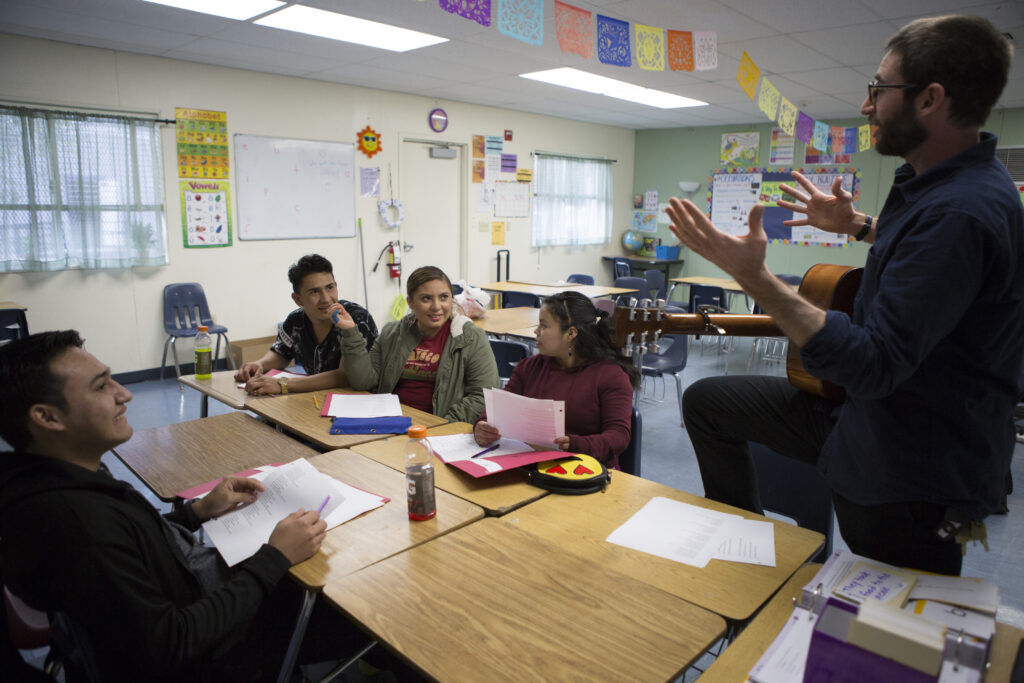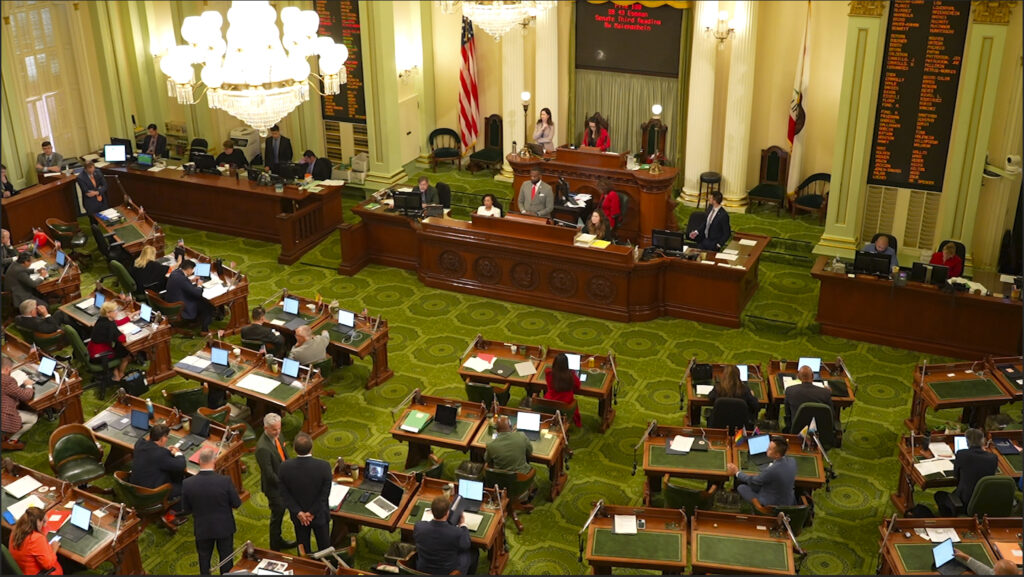
Students at Rudsdale Continuation High School in Oakland, California.
Credit: Anne Wernikoff for Edsource
Magaly Lavadenz was excited about what she felt could be a game-changer for students who are learning English as a second language.
The Center for Equity for English Learners (CEEL) at Loyola Marymount University, which Lavadenz directs, had just won a grant in October 2024 for $5.7 million from the U.S. Department of Education to establish a National Comprehensive Center on English Learners and Multilingualism.
The center would provide resources, training and materials to state education agencies and tribal education agencies so they could, in turn, help districts provide the best support to English learners.
“There was so much excitement about this work,” Lavadenz said.
Then, four months later, in February, Lavadenz received a letter from the U.S. Department of Education terminating the grant and claiming that it violated President Donald Trump’s executive order on diversity, equity, and inclusion, or DEI.
It was a chilling foreshadowing of what would come.
The Trump administration later cut the vast majority of the staff of the Office of English Language Acquisition (OELA), which is charged with administering federal funding for English learners, providing resources and training to schools, and making sure states provide the instruction and services they are required to provide to English learners.
Then, in Trump’s budget request released May 2, he proposed eliminating the federal funding earmarked for English learners and immigrant students under Title III of the Every Student Succeeds Act, the federal education law.
“To end overreach from Washington and restore the rightful role of State oversight in education, the Budget proposes to eliminate the misnamed English Language Acquisition program which actually deemphasizes English primacy by funding NGOs and States to encourage bilingualism,” reads the budget proposal. “The historically low reading scores for all students mean States and communities need to unite—not divide—classrooms using evidence-based literacy instruction materials to improve outcomes for all students.”
Researchers, advocates, and school district administrators say the termination of grants and proposed cuts to funding for schools are misinformed and violate federal law.
“There are civil rights laws that protect English learners,” Lavadenz said. “We believe that the U.S. Department of Education is in violation of those.”
Both Title VI of the Civil Rights Act of 1964 and the Equal Educational Opportunities Act of 1974 require public schools to ensure that English learners can participate fully in school at the same level as their English-speaking peers. The U.S. Supreme Court decided in the Lau v. Nichols case in 1974 that schools must provide additional instruction to students who do not speak English fluently to make sure they can understand the content of their classes.
Education leaders in California said the cuts to Title III would be devastating. Title III funds are sent to state education agencies, like the California Department of Education, to distribute to schools based on the number of immigrant and English learner students they have. They are to be used to help students understand academic content in their classes and to help them learn English.
Debra Duardo, the Los Angeles County superintendent of schools, said she was “deeply concerned” by the Trump administration’s proposal to eliminate Title III. In the 2023-24 school year, schools in L.A. County received approximately $30 million in Title III funding for English learners, she said, which was used for tutoring, support staff, instructional coaching, and high-quality supplemental materials. In addition, they received $2.5 million for immigrant students, which were used to help support family literacy and outreach, school personnel, tutorials, mentoring, and academic and career counseling.
“This decision would have devastating impacts on Los Angeles County schools, where we serve one of the nation’s largest populations of English learners and children from migrant families,” Duardo said.
Lavadenz said if the funds are cut, districts may stop providing services to English learners, or they may remove funding from other areas to keep providing services.
“There’s going to be potential not just for the elimination of services, but we’re going to be pitting student groups against each other,” Lavadenz said.
Nicole Knight, executive director of English Language Learner and Multilingual Achievement at Oakland Unified School District, agreed.
“Ultimately, cutting support for English learners jeopardizes the quality of education for all students, as districts would be forced to divert resources from other critical priorities in order to meet their legal obligations to provide language services,” Knight said.
In addition, a loss of funds would likely mean no federal monitoring, collection of data on English learners, or oversight to make sure states or school districts are actually providing the services they are required to under the law.
“I am devastated to see that work dismantled at the federal level,” said Knight. “It feels like years of progress and good work are being erased.”
Efraín Tovar, who teaches recent immigrant students at Abraham Lincoln Middle School in Selma Unified School District in the Central Valley and is also the founder of the California Newcomer Network, said his district has used Title III funds to buy supplemental curriculum and computer software for newcomer students. He said some districts have used the funds to create innovative Saturday programs for recent immigrant students to help them learn.
“Here in Selma, those funds have helped me directly impact my students’ educational journey,” Tovar said. Every single dollar in public education helps. If those funds are not given by the federal government, the question we have at the local level is, will the state then make it a priority to fund those special programs?”
Many California leaders disagreed with the administration’s arguments that bilingual education or encouraging bilingualism makes students less likely to speak English.
“Decades of research clearly support dual-language and multilingual programs as the most effective models for helping students acquire English and achieve long-term academic success,” Knight said. “I can only hold on to hope that our lawmakers will attend to the evidence, the research, and their conscience to make the right decision for our young people.”
Lavadenz is not convinced, however, that Congress will end up cutting all that funding, especially given that some Republican states like Texas have a long history of encouraging, or even requiring, bilingual education for English learners.
“This is an evolving story,” she said. “The states that have a lot more to lose are not necessarily progressive states like California.”






